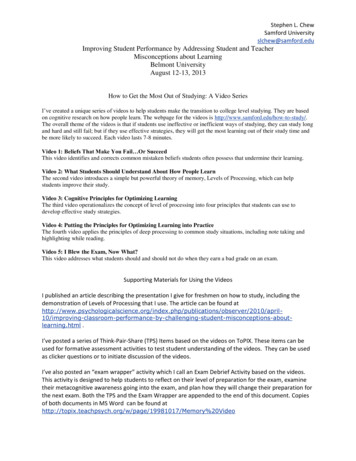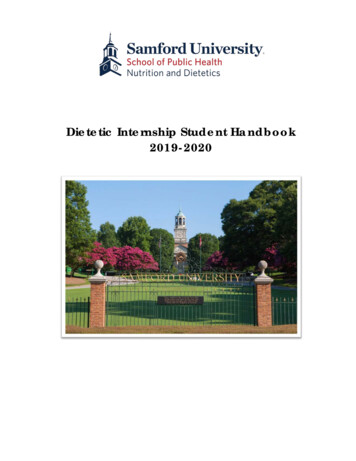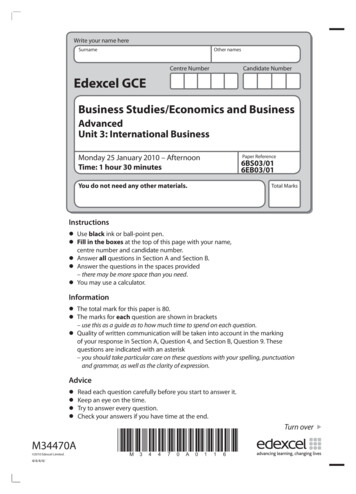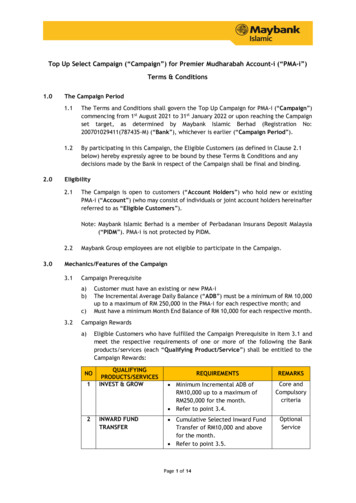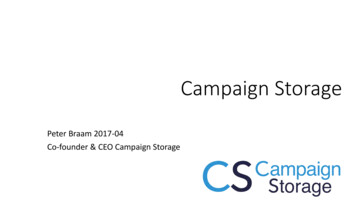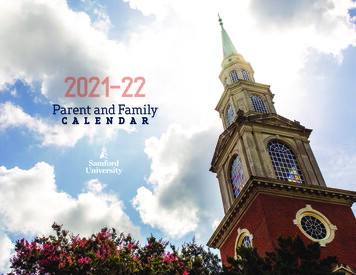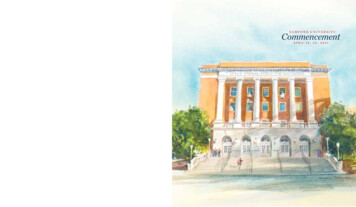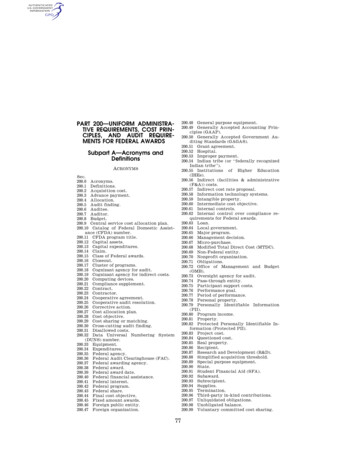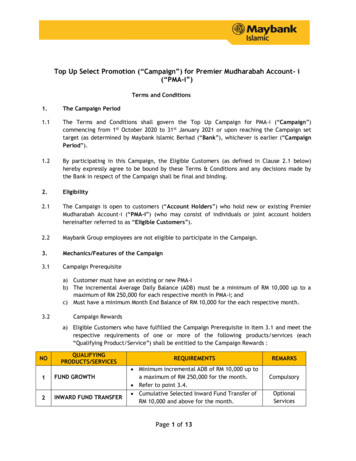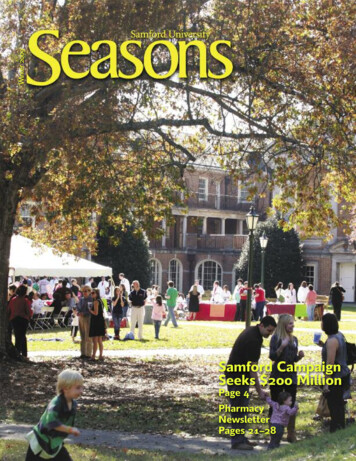
Transcription
Winter 2009Samford CampaignSeeks 200 MillionPage 4PharmacyNewsletterPages 21–28
SEASONSfeatures4Samford Goes for 200 MillionSamford has launched the most ambitious fund-raisingcampaign in its 168-year history, with a goal of raising 200million over the next five years. The money will providefinancial support for the university’s multifaceted, multiyearstrategic plan approved in 2008.12Lincoln RevisitedAbraham Lincoln had great faith but no church membership.He was a southerner whose crusade changed the southernway of life. He all but lost hope for reelection in 1864, butthen Sherman took Atlanta. Drawing on his award-winningbook, The Age of Lincoln, historian Orville Vernon Burtonshared these and other insights in Samford’s annual DavisLecture.14Fall SpectacularThousands of Samford alumni returned to campus on apicture-perfect fall weekend in early November for theannual celebration of homecoming. Enjoy extensivecoverage of the reunion-filled event.30Songs Tell the StoryWhen Ken Burns produced his recent documentary, TheNational Parks: America’s Best Idea, he turned again toalumnus Bobby Horton to select the music. It was their10th collaboration, covering such subjects as the Civil War,baseball, Mark Twain, World War II and others. Hortonmajored in accounting, but made music his life.2 From the President37 Births3 Samford Report38 In Memoriam20 Self and God in Literature40 Campus News21 Pharmacy Newsletter44 Sports32 Alumni46 With Appreciation33 Class Notes48 CalendarCover: The crowd gathers for Homecoming 2009.
EDITORWilliam NunnelleyASSOCIATE EDITORMary WimberleyCONTRIBUTING WRITERSJack Brymer, Sean Flynt, Philip PooleDIRECTOR OF CREATIVE SERVICESJanica York CarterASSISTANT DIRECTOR OFCREATIVE SERVICESLaine WilliamsDESIGNERSScott Camp, Monica WashingtonSENIOR PHOTOGRAPHERCaroline Baird SummersPHOTOGRAPHERRob CulpepperALUMNI ASSOCIATIONOFFICERS 2009–10PRESIDENTGreg Powell ’81VICE PRESIDENT, ACTIVITIESTo Be AnnouncedVICE PRESIDENT, DEVELOPMENTMichael Kopecky ’96ALUMNI COUNCILEXECUTIVE COMMITTEEKitty Brown ’01Jack Brymer ’67Rick Moon ’77Katie Murnane ’07IMMEDIATE PAST PRESIDENTMark Davidson ’92Winter 2009Vol. 26 No. 4Publication Number:USPS 244-800Seasons is published quarterly bySamford University, 800 LakeshoreDrive, Birmingham, Alabama 35229,and is distributed free to alumni ofthe university, as well as to otherfriends. Periodical postage paid atBirmingham, Alabama. Postmaster:send address changes to SamfordUniversity Alumni Office, SamfordUniversity, Birmingham, Alabama35229. 2009 Samford UniversitySamford University is an Equal OpportunityInstitution that complies with applicable lawprohibiting discrimination in its educationaland employment policies and does not unlawfully discriminate on the basis of race, color,sex, age, disability, or national or ethnic origin.www.samford.edusamnews@samford.eduProduced by Samford Office ofCommunication
FROMTHEPRESIDENTOn Your Mark.Get Set.Afew years ago, Runner’s World magazinefeatured an article revealing the strangemagic of Norway’s Bislett Stadium. The oldstadium was replaced by a newer version in 2005,but the original venue functioned for most of the20th century. Obviously something was specialabout the old facility, because more than 65 worldrecords were set there in track and field and speedskating. No other stadium even approaches such aclaim. Researchers traced the cause of thephenomenon, known to athletes as the “Bisletteffect,” not to the cold weather, nor to the windresistance, nor the altitude, but to the design ofthe stadium itself. The narrow lanes weresurrounded by steep grandstands, placing thespectators remarkably close to the athletes. Theroar of thousands of fans—such a great cloud ofwitnesses—propelled each runner forward.Although, given the nature of their sport,they weren’t pressed on every side by fans in thegrandstands, the members of our women’s crosscountry team must have experienced a version ofthe Bislett effect this fall as they ran away withSamford’s first championship since joining theSouthern Conference. What lessons can we learnfrom these remarkable student-athletes?Commitment. Our team was the preseasonfavorite to win the championship, which onlyenhanced the pressure of each performance. Witheach meet, they worked to give their best.Perseverance. The weather was a factoralmost every week of the season, from extremeheat and humidity to rain. Hillary Neal, a juniornursing major from Palm Beach Gardens, Fla.,said, “It’s been a crazy season. We could’ve gottendown on ourselves, but we persevered . . . and gotit done.”Balance. Members of the team are committedathletes and committed students. The team hasachieved a perfect score of 1,000 on the NCAAAcademic Progress Report each year since theinception of the ratings, measuring academicprogress, persistence and graduation.Commitment, perseverance and balance:qualities that will serve these young women wellin the years beyond their cross-country careers,and qualities to which we all aspire.As always, please keep Samford in yourprayers.Andrew WestmorelandPresident2
SAMFORDreportVann Works To Avoid the Pitfall of the Stalehat challenge doesuse in our lives.”Dr. Lowell VannStudents nominatingface after teachingVann for the Buchananfull-time since 1970?award described him as a“Striving to stay fresh,“hard, productive andavoiding the stale, realizinglearned teacher who giveseach new year’s class hashis all and more to hisnever been down this roadstudents,” and as a probefore,” he said.fessor “who makes art funVann received the 2009and opens the eyes of thoseJohn H. Buchanan Award forwho take his course forExcellence in Classroomeven just an elective.”Teaching at Samford duringHe holds the master ofthe semester-opening convofine arts degree from thecation Aug. 25, about theUniversity of Alabama andDr. Lowell Vannsame time he met his latestthe Ph.D. from Florida Stategroup of new students.University.A 1957 Samford graduDoes anything surate, Vann joined the faculty full-time inprise Vann in the classroom?1970 after teaching part-time for several“A student’s unexpected forwardyears. He served as art department chairprogress, a venture on their part thatfor 36 years.really pays off,” he answered. “It makesThe veteran professor definesyou wonder what the impediment wasteaching as “an interaction with studentsbefore and how it could have beenin a quest for learning.” He added, “This ismoved aside earlier.” not a mere accumulation of information,but the application of what we learn toW4,658Samford Enrolls a Recordamford, Alabama’s largest privateuniversity for many years, hasgotten even larger. The university’sofficial enrollment for 2009 is 4,658students. That exceeds the previousrecord of 4,630 in 1995. Last year’s totalwas 4,469.Samford enrolled 2,908 undergraduates and a record 1,750 graduatestudents this fall.Dr. Phil Kimrey, vice president forstudent affairs and enrollment management, noted that this year’s freshmanclass had an average ACT collegeentrance exam score of 26, significantlyhigher than the national average of 21.About one-fourth of the class ranked inthe top 10 percent of their high schoolgraduating class. Fifteen were NationalMerit Scholarship finalists.Ida V. Moffett School of Nursingrecorded the largest increase in enrollment, growing from 403 students to509, Samford President AndrewWestmoreland noted. This reflectsincreased national interest in health-careeducation, and aggressive recruitmentefforts by the nursing school, he said.Samford’s pharmacy and lawschools also have increased enrollments.“I’m grateful to every member ofthe campus community for these greatefforts to maintain and enhance enrollment during a period of economicstress,” said Dr. Westmoreland. SBrock National Finalistamford’s Brock School of BusinessEntrepreneurship Program was selected as one of three national finalists for theOutstanding Emerging EntrepreneurshipProgram by the U.S. Association of SmallBusiness and Entrepreneurship [USASBE]. The award recognizes top programsin existence three years or less.“One strategic goal at Brock School ofBusiness is to build one of the top programs in the country for training aspiringentrepreneurs, and this award validatesour efforts to date,” said Franz Lohrke, theBrock Family Chair in Entrepreneurship.Other finalists include the Universityof Rochester and Creighton University.The top program will be selected atUSASBE’s annual conference in January2010. SMike Roylance, principal tubist for the Boston Symphony Orchestra, performs with theSamford Wind Ensemble Oct. 22 in Brock Recital Hall at Samford. Roylance also hasperformed with the Chicago Symphony, Minnesota Orchestra and Seattle Symphony.3
SPECIALREPORTA C A M PA I G NFORSAMFORDLargest Fund-raisingEffort Seeks 200 Million 84 Million Already Given or Pledged4by Philip Poole
SPECIALREPORTamford University has launched the mostambitious fund-raising campaign in theuniversity’s 168-year history with a goalof raising 200 million over the next fiveyears. The campaign, several months inplanning, was announced publicly Oct. 9.A total of 84 million already has been givenor pledged, noted Samford President AndrewWestmoreland.The campaign provides financial support forSamford’s multifaceted, multiyear strategic planthat was approved and announced by the university’sboard of trustees in September 2008. The strategicplan and the campaign both support the academicpriorities of the university and provide for theneeds of students, said Dr. Westmoreland.Key components of the campaign are fundsfor scholarships, academic programs such asendowed chairs and professorships, annual support of university operations and capital projects.University administrators and campaignleadership acknowledged the unusual economicclimate in which the campaign launched. But,campaign leaders are convinced that the effort canbe successful.“We are aware that these are tough economictimes, and people might ask ‘Isn’t this a strangetime to be starting a capital campaign?’” saidcampaign chair Albert P. Brewer, former Alabamagovernor and retired Samford law professor.“Our needs are even greater and morepronounced now, and the needs of our studentsand the opportunities that we have to minister tothem are greater now because of these [economic]circumstances,” said Brewer.“This is a time when we must go forwardwith our campaign in view of those conditions.C A M PA I G NCABINETAlbert Brewer, ChairFormer Governor, Stateof AlabamaRetired Law Professor,Samford UniversityBirmingham, AlabamaPaula Hovater ’69President, Public AffairsAtlanta, GeorgiaEddie Miller ’74Bodine, Inc.Birmingham, AlabamaWe believe that people recognize the needs that wehave, that they recognize the importance of whatwe’re trying to do for our students by way ofscholarships and enhanced research and facilitieshere. I believe that people are going to respondaffirmatively and positively to what we’re trying todo because it is so essential that we do it now.”The largest campaign component, about 65million, is designated for scholarships. Funds willbe used for existing scholarship programs, rangingin vintage from the one-year-old UniversityFellows for top academic students to the 80-yearold Samford marching band. Additional endowment will provide new program-specific andneeds-based scholarships, Westmoreland noted.Officials said scholarship funding is critical,especially in today’s economy, as SamfordVic Nichol ’68CEO, Alabama Bankers BankBirmingham, AlabamaJohn Pittman ’44Retired Insurance ExecutiveBirmingham, AlabamaWilliam Stevens ’70CEO, Motion IndustriesBirmingham, AlabamaClark Watson, J.D. ’81Attorney, Balch & BinghamBirmingham, AlabamaElouise WilliamsCommunity Volunteerand PhilanthropistBirmingham, AlabamaE X O F F I C I O,SAMFORDUNIVERSITYAndrew WestmorelandPresidentRandy PittmanVice President for UniversityAdvancementDouglas Wilson ’83Executive Director ofAdvancement 5
SPECIALREPORTcompetes to attract top students.“One very important goal of thiscampaign is scholarships,” said SamfordProvost J. Bradley Creed. “We want qualified students to be able to receive a college education, which is one of the mostlife-changing experiences that any humanbeing can have. That is why a significantpart of this campaign is dedicated toscholarships to enable qualified studentsin need of assistance to come to Samfordand have this life-changing experience.”In addition to scholarship funding,the campaign also will support academicprograms and faculty. About 25 millionis earmarked in the campaign for facultyenrichment and academic programs.“As the largest private university inAlabama and one of the top privateschools in the region, it is imperative thatour faculty and academic programmingreflect that status,” said W. RandallPittman, Samford’s vice president foruniversity advancement.Income from endowed academicchairs and professorships will fundresearch, and help to attract and retainquality faculty “to join our team ofesteemed professors,” Pittman said. Otherfunds will be used to support existing ornew academic programs in each ofSamford’s eight schools.An unusual component of the campaign is 60 million for annual support.Most major institutional campaigns focuson capital or new projects, but becauseWhere the Money Will GoScholarships 65 MillionFunds will be used for existing scholarship programs, ranging in vintage fromthe one-year-old University Fellows fortop academic students to the 80-yearold Samford marching band. Additionalendowment will provide new programspecific and needs-based scholarships.Faculty Enhancements 25 MillionIncome from endowed academic chairsand professorships will fund research,and help to attract and retain qualityfaculty to join Samford’s nationallyrecognized faculty.Academic Programs 10 millionFunds will be used to support existingor new academic programs in each ofSamford’s eight schools.6Campus Facilities 40 millionThe Cooney Family Field House forfootball, completed in summer 2009, isa capital project included in the campaign. Other projects being consideredare an expanded and renovated studentcenter, and residence facilities andacademic buildings for Samford’sburgeoning student population. Capitalprojects will be undertaken as fundingis available.Annual Fund Support 60 millionMost major institutional campaignsfocus on capital or new projects, butbecause tuition revenue alone cannotsupport a major university such asSamford, annual giving to support dayto-day instructional needs is crucial. For more information, go towww.samford.edu/campaign.tuition revenue alone cannot support amajor university such as Samford, annualgiving to support day-to-day instructionalneeds is crucial, Pittman said.“Tuition revenue is designated forinstructional costs, but ongoing operational needs are just as critical,” heexplained. “A sprawling campus requirescare and maintenance. Library resourcesand school-based equipment must bereplaced. Continuously changing technology needs must be met. Resourcesmust be available for growth in studentenrollment.
Samford’s burgeoning student population.Capital projects will be undertaken asfunding is available.A steering committee of volunteers,chaired by Brewer, is assisting theuniversity’s administration with thecampaign. (See listing on page 5.)Westmoreland and Brewer anticipate strong support from all Samfordconstituencies. The campaign alreadyhas been endorsed by a unanimous voteof Samford’s board of trustees.“One might ask why the communityshould be involved in or support theSamford campaign,” Brewer said.Samford Made Him a Well-RoundedPharmacist, Believes Patrick Devereuxhether Patrick Devereux, Pharm.D. ’05, iscounseling a patient at his community pharmacy,mentoring a student or presiding at his RotaryClub, he can trace his passion for the activity to his SamfordUniversity student days.He had already claimed the profession for his futurevocation when he entered Samford, having been drawn to thecareer while working at a pharmacy as a high school studentin St. Augustine, Fla.“I liked the personal interaction between the pharmacistsand patients,” said Devereux, who identified his particularniche after entering the professional curriculum at Samford’sMcWhorter School of Pharmacy.“I decided on independent community pharmacythrough my involvement with student organizations inpharmacy school, especially the National CommunityPharmacists Association,” he said.Advancing quickly in his career, he is now vice presidentof clinical services at Family Medical Services, Inc., and managing pharmacist at the company’s Bessemer, Ala., location.Earlier this year, he received the pharmacy school’sShaddix Award, an honor given to recognize a graduate whohas made a difference in pharmacy within five years ofgraduation.Devereux was cited for his efforts to create andimplement new forms of pharmacy services. Specifically, hegarnered the accolade for his implementation of medicationtherapy management [MTM]. MTM encompasses a varietyof patient-specific and specialized services—all designed tohelp patients improve their medication use.The MTM concept is important to him and to hispatients, says Devereux, because informed and empoweredpatients make the best health decisions.“If I am able to provide some peace of mind to patientswith their medications, while at the same time reducing oreliminating drug interactions and adverse reactions, I havetruly done my job as a pharmacist,” said Devereux.Too often, he explains, patients are given prescriptions bytheir doctor with little or no guidance as to what to expect, orhow a medication fits in with their health-care plan.“That is where we come in and why medication therapyW“Samford is an integral part of thiscommunity and proud to be a part ofthe community. We participate in andprovide many of the cultural activities ofthe community. We’re good corporatecitizens. We educate the young people ofthe community. So, the community has areal stake in the success of our campaignbecause of what we’re doing atSamford.”Westmoreland added, “We need thehelp of all friends of Samford. Certainly,these goals are lofty, but they areattainable if the Samford constituencyrallies around this great cause.” SPECIALREPORT“Even with Samford’s prudentfinancial management, it is a challengefor tuition costs to remain affordable formost students while providing adequatefunds for the university’s physical plantand other needs. That is why annualgiving is so important,” Pittmancontinued.The Cooney Family Field House forfootball, completed in August, is acapital project included in the campaign,Westmoreland said. Other projects beingconsidered are an expanded and renovated student center, and residencefacilities and academic buildings forby Mary Wimberleymanagement is so important,” he said.Devereux gladly incorporates his patient-care experiences into lectures he gives on campus and in his work as apreceptor to pharmacy students who do a rotation at hisstore.“I do this to offer some real-world perspective to thestudents. This helps reinforce what they are currentlystudying and shows them that there are different avenues inpharmacy open to them,” said Devereux.President-elect of Rotary International’s ShadesMountain Sunrise Club, Devereux is active in JeffersonCounty and Alabama pharmacy associations, NationalCommunity Pharmacists Association and the AmericanAssociation of Diabetes Educators. He is also a member ofthe pharmacy school’s newly formed leadership team.This commitment to community service and professionaldevelopment can be traced back to his Samford roots.“Many of my professors taught me that this was the wayto shape the future of our profession and give back to thecommunity through service,” said Devereux, who served aspresident of his 2005 pharmacy class.Devereux’s decision to attend Samford came easy, in partbecause he had already made his career choice in high school.“I wanted to attend a school where I would be able to doboth my undergraduate work and attend pharmacy school,”said Devereux, who researched possible schools around thecountry. “I was convinced that Samford was the school forme when I made a campus visit. It felt like home to me.”Now, five years out of school, he remains very happywith his choice.“I believe I emerged from Samford a well-roundedpharmacist,” said Devereux, who participated in a variety ofcampus activities outside of pharmacy. “My experience inundergraduate Greek life formed friendships with people thatI am still very close to and see regularly.”Perhaps Devereux’s strongest testimonial for Samford ishis desire that his younger sister choose to attend his almamater.“I think she will benefit from the sense of communityand friendship that helped me to get where I am today.”Not a bad endorsement. 7
Giving Backto Samford aHallmark ofCampaign Chairman Brewerby Mary Wimberleyormer Alabama governorAlbert P. Brewer has servedSamford University in manyways through the years: distinguished professor of law andgovernment, founding president of theSamford-based Public Affairs ResearchCouncil of Alabama, trustee andunofficial goodwill ambassador.The partially retired Brewer foundit hard to refuse Dr. AndrewWestmoreland when the Samford president asked him to take on one morerole: that of steering committee chair for“A Campaign for Samford.”“Samford has meant much to manyof us, and the campaign is a way ofgiving back to this great university,” saidBrewer.” The opportunities here areimpressive and can be realized only withadditional resources.”His appreciation for the schoolbegan several decades before he joinedthe faculty in 1987.“I have known Samford all my life,first as Howard College, then asSamford,” recalled Brewer, who, as ayoung attorney and Baptist layman inMorgan County, was a campaign leaderto raise funds for the school’s move fromEast Lake to Homewood in the 1950s.In the 1960s, he was a member ofthe Alabama legislature when the namewas changed from Howard College toSamford University, and in 1968, hereceived an honorary degree from theschool.F8Brewer and his late wife, Martha,underscored their long-standing appreciation for the school by establishingscholarships for undergraduate and lawstudents.“We wanted to help students whomight otherwise be unable to attendSamford,” said Brewer, noting that thecouple delighted in following the careersof recipients and having pride in theiraccomplishments.An additional scholarship has beenestablished in his honor, and in 2008,the striking Martha F. and Albert P.Brewer Plaza at Samford was madepossible by statewide contributionsfrom a broad cross-section of people.The site in front of the law schoolbuilding, Robinson Hall, is enjoyed byall Samford students and faculty.Brewer, who has taught Samfordlaw students as well as undergraduatehistory and political science students,was honored in 2001 with Samford’sGeorge Macon Memorial Award foroutstanding performance as a teacher.One nominator hailed Brewer forhis generosity of time as he patientlyhelped students understand the intri cacies of the legal and political systemsof Alabama, and also for his manyadmirable personal attributes.“He exudes from the core of hisbeing an unwavering commitment tothe highest ideals of the legal profession:justice, compassion and the importanceof contributing to one’s community,”said the nominator.Brewer was lieutenant governor ofAlabama during 1967–68 and governorduring 1968–71. He is recognized forachieving much-needed reforms andnew programs for the state. Historianshave called him Alabama’s first NewSouth governor.His numerous honors and accolades cite, among other things, hiscommitment to state constitutionalreform efforts. He has been a boardmember of the Alabama Citizens forConstitutional Reform and the AlabamaCitizens Constitution Commission.Brewer retired from full-timeteaching in 2005 but continues toteach a law course in professionalresponsibility.Although a graduate of theUniversity of Alabama with bachelor’sand law degrees, Brewer is never shyabout his pride in Samford, its missionand its worthiness of support.“Samford is a special place,” said Brewer.“Its ability to provide a Christian highereducation is dependent upon ourproviding the resources to achieve ourcampaign objectives.“Every contribution is an investment in the future of the outstandingyoung people who attend Samford, andof our state and nation, and even theworld, where they will serve withcharacter and ability.”
9SPECIALREPORT
10SPECIALREPORT
Step by StepSPECIALREPORTFulfilling a Goalby Mary Wimberleyindsay Harter feels called to acareer in medical missions, andthe 2009 Samford nursinggraduate is preparing—step bystep—to fulfill her goal.As a participant in the registerednurse intern program at the University ofAlabama at Birmingham, Harter hopesto work in an emergency room after shecompletes rotations through five units.The ER, she reasons, will best prepare herfor the challenges of medical missions.In June, she participated in amedical mission trip to the DominicanRepublic with Christian MedicalMinistry of Alabama. “That experienceas a translator/nurse only confirmed mycalling to participate in sharing the loveof Jesus in needy places by providingmedical care,” said Harter, who eventually wants to earn a graduate degreeand become a nurse practitioner beforeheading to the mission field.Her very first step, enrolling atSamford to study nursing, however,involved a giant leap of faith to overcomea financial obstacle.Harter originally had not consideredSamford for her education. Although herolder brother, Zach Harter ’06, hadenjoyed his time at the school, she preferred to attend a large public universityin her home state of Georgia.“I wanted to discover new territory.If I wanted to continue in that mindset,however, I made a big mistake by visitinghim on Step Sing weekend,” said Harter,who immediately “fell in love” with thestudent body and campus.She was later impressed withSamford’s nursing program when sheattended the school’s Academic OptionsDay, an experience that only strengthenedher desire to attend.“One significant problem was in myLway, however—money,” said Harter.Her prayers for financial assistancewere answered in a big way when she wasselected to receive a highly competitivePresidential Scholarship, which herbrother also had received.She quickly became involved incampus life and community causes.During her freshman and sophomoreyears, she led the Invisible Childreninitiative of University Ministries’ SocialJustice Committee. She later helpedorganize the citywide Global NightCommute, a simulation of the nightlycommute that children of northernUganda make to avoid being captured bymembers of a rebel army.Just before her senior year, however,a significant tuition increase madeHarter fearful that, even with herPresidential Scholarship, she would needto complete her nursing educationelsewhere.Shortly before that tuition was due,she learned that she had received aSamford University Auxiliary scholarshipthat would help cover her senior year.“I wept at the feet of Jesus indisbelief and another lesson learned,”Harter said.Through the years, scores of gratefulSamford students have benefited fromauxiliary scholarships. The endowedfund, in excess of 1 million dollars, isfunded primarily by individuals withadditional support from corporationsand foundations. This year, the auxiliaryprovided more than 65,000 in scholarships from the endowment.Harter is appreciative of thegenerosity of those who made both herpresidential and auxiliary scholarshipspossible. Her words of gratitude are compelling.“If I could say anything to donors, itwould be this: You are not someone whojust gives money to Samford,” saidHarter. “You are someone who God usesto completely redirect the course of aman or woman’s life—their career,possibly who they marry, their spiritualgrowth and their entire outlook on life.”College, she says, is an “absolutelycritical time” for all of these things asstudents make the transition fromadolescence to independent adulthood.“That is an enormous responsibility,but an even greater privilege for you,” shesays to donors. “I hope to be able to dothe same one day.” 11
DAVISLECTURE‘He Revolutionized PersonalFreedom in the U.S.’by William Nunnelleybraham Lincoln proclaimedearly in 1865 that theEmancipation Proclamationwas “the central act of myadministration and thegreat event of the nineteenth century.”But Lincoln historian Orville VernonBurton disagrees.“Instead, it was Lincoln’s understanding of liberty that became thegreatest legacy of the age,” Burton said atSamford University. “He revolutionizedpersonal freedom in the U.S. He assuredthat the principle of personal liberty wasprotected by law, even incorporated intothe Constitution.“Thus Lincoln elevated the foundingfathers’ (and Andrew Jackson’s) morerestricted vision to a universal one.Basically, Lincoln inserted the missionstatement, or Declaration ofIndependence, into the Constitution, orrule book, of the United States.”Burton is author of The Age ofLincoln, which won the Chicago TribuneHeartland Literary Award for Nonfictionin 2007. He delivered Samford’s annual J.Roderick Davis Lecture Oct. 22, basinghis talk on his book.The historian’s identification ofLincoln’s greatest legacy was one of fourareas he focused on in which he eitheroffered new arguments or differed withmost Civil War scholars. The other areaswere the influence of religion, Lincoln’s“Southernness” and history’s conventional treatment of the Civil War andReconstruction as separate periods.Burton also offered several thoughtprovoking “what-if” interpretations toevents of the period.“History is an interpretation,” hereminded his audience of about 1,000students and others in Wright Center.ALincoln and ReligionBurton stressed the importance ofreligion as a factor in the coming of the12Civil War. “In order to understandsecession, and to understand how menthought
Other finalists include the University of Rochester and Creighton University. The top program will be selected at USASBE's annual conference in January 2010. Mike Roylance, principal tubist for the Boston Symphony Orchestra, performs with the Samford Wind Ensemble Oct. 22 in Brock Recital Hall at Samford. Roylance also has

